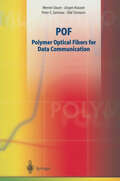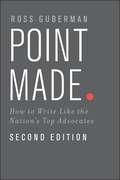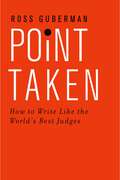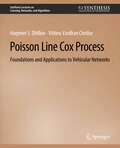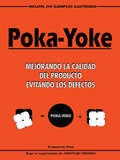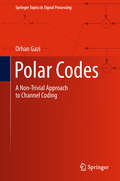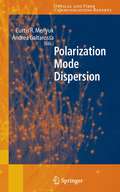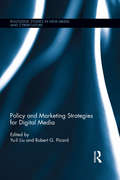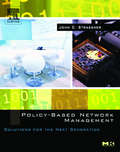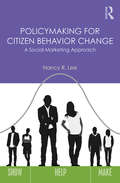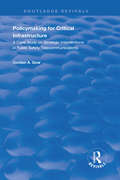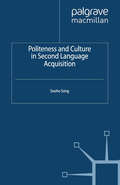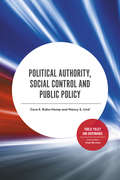- Table View
- List View
POF-Handbuch: Optische Kurzstrecken-Übertragungssysteme
by Olaf Ziemann Jürgen Krauser Peter E. Zamzow Werner DaumDie 2. Auflage erscheint komplett neu bearbeitet und aktualisiert in doppeltem Umfang und in durchgängig farbiger Ausstattung: über 1000 Abbildungen, 600 Literaturstellen und zahlreiche Tabellen. Das Handbuch zeigt vorhandene Lösungen und das Potenzial zukünftiger Anwendungen. Das Polymerfaser-Anwendungszentrum der FH Nürnberg begleitete die Neugestaltung. Noch vor wenigen Jahren war die POF-Technologie (Polymer-optische Faser) wenig verbreitet. Inzwischen wird sie in den Bordnetzen vieler Millionen PKWs und vermehrt auch in Gebäudenetzen eingesetzt.
POF - Optische Polymerfasern für die Datenkommunikation
by Olaf Ziemann Jürgen Krauser Peter E. Zamzow Werner DaumPOF - optische Polymerfasern oder vereinfachend polymeroptische Fasern - sind eine noch junge Technologie mit zunehmender Beliebtheit in der Kommunikationstechnik. Die Vorteile sind groß, wie werden sie eingesetzt? Unterschiedliche Systeme der jungen, wichtigen Technologien werden beschrieben. Damit erhält der Leser eine Einführung und einen Überblick. Punkt-zu-Punkt-Systeme, also die Übertragung eines Kanals vom Sender zum Empfänger, und Wellenlängen-Multiplexsysteme, also die Übertragung mehrerer Kanäle über eine Faser mit unterschiedlichen Lichtwellenlängen, werden behandelt. Die hohe Qualität der Inhalte wird begleitet durch eine durchgängig farbige hochwertige Ausstattung des Buchs.
POF - Polymer Optical Fibers for Data Communication
by Olaf Ziemann Jürgen Krauser Peter E. Zamzow Werner DaumWritten by some of the best known POF experts from Germany, one of the leading countries in POF technology, this is the most comprehensive introduction and survey of POF data communication systems currently available. Featuring recent experimental results and over 600 coloured figures and tables.
Point Made: How to Write Like the Nation's Top Advocates
by Ross GubermanWith Point Made, legal writing expert, Ross Guberman, throws a life preserver to attorneys, who are under more pressure than ever to produce compelling prose. What is the strongest opening for a motion or brief? How to draft winning headings? How to tell a persuasive story when the record is dry and dense? The answers are "more science than art," says Guberman, who has analyzed stellar arguments by distinguished attorneys to develop step-by-step instructions for achieving the results you want. The author takes an empirical approach, drawing heavily on the writings of the nation's 50 most influential lawyers, including Barack Obama, John Roberts, Elena Kagan, Ted Olson, and David Boies. Their strategies, demystified and broken down into specific, learnable techniques, become a detailed writing guide full of practical models. In FCC v. Fox, for example, Kathleen Sullivan conjures the potentially dangerous, unintended consequences of finding for the other side (the "Why Should I Care?" technique). Arguing against allowing the FCC to continue fining broadcasters that let the "F-word" slip out, she highlights the chilling effect these fines have on America's radio and TV stations, "discouraging live programming altogether, with attendant loss to valuable and vibrant programming that has long been part of American culture." Each chapter of Point Made focuses on a typically tough challenge, providing a strategic roadmap and practical tips along with annotated examples of how prominent attorneys have resolved that challenge in varied trial and appellate briefs. Short examples and explanations with engaging titles--"Brass Tacks," "Talk to Yourself," "Russian Doll"--deliver weighty materials with a light tone, making the guidelines easy to remember and apply. In addition to all-new examples from the original 50 advocates, this Second Edition introduces eight new superstar lawyers from Solicitor General Don Verrilli, Deanne Maynard, Larry Robbins, and Lisa Blatt to Joshua Rosencranz, Texas Senator Ted Cruz, Judy Clarke, and Sri Srinvasan, now a D.C. Circuit Judge. Ross Guberman also provides provocative new examples from the Affordable Care Act wars, the same-sex marriage fight, and many other recent high-profile cases. Considerably more commentary on the examples is included, along with dozens of style and grammar tips interspersed throughout. Also, for those who seek to improve their advocacy skills and for those who simply need a step-by-step guide to making a good brief better, the book concludes with an all-new set of 50 writing challenges corresponding to the 50 techniques.
Point Made: How to Write Like the Nation's Top Advocates
by Ross GubermanWith Point Made, legal writing expert, Ross Guberman, throws a life preserver to attorneys, who are under more pressure than ever to produce compelling prose. What is the strongest opening for a motion or brief? How to draft winning headings? How to tell a persuasive story when the record is dry and dense? The answers are "more science than art," says Guberman, who has analyzed stellar arguments by distinguished attorneys to develop step-by-step instructions for achieving the results you want. The author takes an empirical approach, drawing heavily on the writings of the nation's 50 most influential lawyers, including Barack Obama, John Roberts, Elena Kagan, Ted Olson, and David Boies. Their strategies, demystified and broken down into specific, learnable techniques, become a detailed writing guide full of practical models. In FCC v. Fox, for example, Kathleen Sullivan conjures the potentially dangerous, unintended consequences of finding for the other side (the "Why Should I Care?" technique). Arguing against allowing the FCC to continue fining broadcasters that let the "F-word" slip out, she highlights the chilling effect these fines have on America's radio and TV stations, "discouraging live programming altogether, with attendant loss to valuable and vibrant programming that has long been part of American culture." Each chapter of Point Made focuses on a typically tough challenge, providing a strategic roadmap and practical tips along with annotated examples of how prominent attorneys have resolved that challenge in varied trial and appellate briefs. Short examples and explanations with engaging titles--"Brass Tacks," "Talk to Yourself," "Russian Doll"--deliver weighty materials with a light tone, making the guidelines easy to remember and apply. In addition to all-new examples from the original 50 advocates, this Second Edition introduces eight new superstar lawyers from Solicitor General Don Verrilli, Deanne Maynard, Larry Robbins, and Lisa Blatt to Joshua Rosencranz, Texas Senator Ted Cruz, Judy Clarke, and Sri Srinvasan, now a D.C. Circuit Judge. Ross Guberman also provides provocative new examples from the Affordable Care Act wars, the same-sex marriage fight, and many other recent high-profile cases. Considerably more commentary on the examples is included, along with dozens of style and grammar tips interspersed throughout. Also, for those who seek to improve their advocacy skills and for those who simply need a step-by-step guide to making a good brief better, the book concludes with an all-new set of 50 writing challenges corresponding to the 50 techniques.
Point Taken: How to Write Like the World's Best Judges
by Ross GubermanIn Point Taken, Ross Guberman delves into the work of the best judicial opinion-writers and offers a step-by-step method based on practical and provocative examples. Featuring numerous cases and opinions from 34 esteemed judges - from Learned Hand to Antonin Scalia - Point Taken, explores what it takes to turn "great judicial writing" into "great writing". Guberman provides a system for crafting effective and efficient openings to set the stage, covering the pros and cons of whether to resolve legal issues up front and whether to sacrifice taut syllogistic openings in the name of richness and nuance. Guberman offers strategies for pruning clutter, adding background, emphasizing key points, adopting a narrative voice, and guiding the reader through visual cues. The structure and flow of the legal analysis is targeted through a host of techniques for organizing the discussion at the macro level, using headings, marshaling authorities, including or avoiding footnotes, and finessing transitions. Guberman shares his style "Must Haves", a bounty of edits at the word and sentence level that add punch and interest, and that make opinions more vivid, varied, confident, and enjoyable. He also outlines his style "Nice to Haves", metaphors, similes, examples, analogies, allusions, and rhetorical figures. Finally, he addresses the thorny problem of dissents, extracting the best practices for dissents based on facts, doctrine, or policy. The appendix provides a helpful checklist of practice pointers along with biographies of the 34 featured judges.
Point Taken: How to Write Like the World's Best Judges
by Ross GubermanIn Point Taken, Ross Guberman delves into the work of the best judicial opinion-writers and offers a step-by-step method based on practical and provocative examples. Featuring numerous cases and opinions from 34 esteemed judges - from Learned Hand to Antonin Scalia - Point Taken, explores what it takes to turn "great judicial writing" into "great writing". Guberman provides a system for crafting effective and efficient openings to set the stage, covering the pros and cons of whether to resolve legal issues up front and whether to sacrifice taut syllogistic openings in the name of richness and nuance. Guberman offers strategies for pruning clutter, adding background, emphasizing key points, adopting a narrative voice, and guiding the reader through visual cues. The structure and flow of the legal analysis is targeted through a host of techniques for organizing the discussion at the macro level, using headings, marshaling authorities, including or avoiding footnotes, and finessing transitions. Guberman shares his style "Must Haves", a bounty of edits at the word and sentence level that add punch and interest, and that make opinions more vivid, varied, confident, and enjoyable. He also outlines his style "Nice to Haves", metaphors, similes, examples, analogies, allusions, and rhetorical figures. Finally, he addresses the thorny problem of dissents, extracting the best practices for dissents based on facts, doctrine, or policy. The appendix provides a helpful checklist of practice pointers along with biographies of the 34 featured judges.
Poisson Line Cox Process: Foundations and Applications to Vehicular Networks (Synthesis Lectures on Learning, Networks, and Algorithms)
by Harpreet S. Dhillon Vishnu Vardhan ChetlurThis book provides a comprehensive treatment of the Poisson line Cox process (PLCP) and its applications to vehicular networks. The PLCP is constructed by placing points on each line of a Poisson line process (PLP) as per an independent Poisson point process (PPP). For vehicular applications, one can imagine the layout of the road network as a PLP and the vehicles on the roads as the points of the PLCP. First, a brief historical account of the evolution of the theory of PLP is provided to familiarize readers with the seminal contributions in this area. In order to provide a self-contained treatment of this topic, the construction and key fundamental properties of both PLP and PLCP are discussed in detail. The rest of the book is devoted to the applications of these models to a variety of wireless networks, including vehicular communication networks and localization networks. Specifically, modeling the locations of vehicular nodes and roadside units (RSUs) using PLCP, the signal-to-interference-plus-noise ratio (SINR)-based coverage analysis is presented for both ad hoc and cellular network models. For a similar setting, the load on the cellular macro base stations (MBSs) and RSUs in a vehicular network is also characterized analytically. For the localization networks, PLP is used to model blockages, which is shown to facilitate the characterization of asymptotic blind spot probability in a localization application. Finally, the path distance characteristics for a special case of PLCP are analyzed, which can be leveraged to answer critical questions in the areas of transportation networks and urban planning. The book is concluded with concrete suggestions on future directions of research. Based largely on the original research of the authors, this is the first book that specifically focuses on the self-contained mathematical treatment of the PLCP. The ideal audience of this book is graduate students as well as researchers in academia and industry who are familiar with probability theory, have some exposure to point processes, and are interested in the field of stochastic geometry and vehicular networks. Given the diverse backgrounds of the potential readers, the focus has been on providing an accessible and pedagogical treatment of this topic by consciously avoiding the measure theoretic details without compromising mathematical rigor.
Poka-yoke (Spanish): Mejorando la Calidad del Producto Evitando los Defectos
by H. HiranoMuchas cosas pueden ir mal en un entorno de trabajo. Cada dia hay oportunidades para cometer errores que resultaran en defectos. Los defectos son despilfarro y, si no se descubren, frustran las espectativas del cliente sobre la calidad. Detras del poka-yoke esta la conviccion de que no es aceptable producir incluso un pequeno numero de articulos defectuosos. Durante mas de 200 visitas a fbricas Japonesas, Productivity ha presenciado el impacto de simples mecanismos poka-yoke instalados por los propios trabajadores para evitar la ocurrencia de defectos. En este libro, 240 ejemplos poka-yoke despertaran su imaginacion para planificar e implantar sistemas de prevencion de errores.Contenido:Errores de proceso Errores de montaje Errores de ensamble Inclusion de items erroneos Errores de insercion Omisiones en montaje Omisiones en proceso Errores de medicion Errores dimensionales Omision de operaciones Errores de operacion Errores de pegado Errores de inspeccion Errores de cableado Errores de pintura Errores de impresion Desalineamientos Errores en preparacion de mquinas Errores de embalaje Desajuste de plantillas y utiles Errores de lavado Problemas miscelaneos
Poka-yoke (Spanish): Mejorando la Calidad del Producto Evitando los Defectos
by H. HiranoMuchas cosas pueden ir mal en un entorno de trabajo. Cada dia hay oportunidades para cometer errores que resultaran en defectos. Los defectos son despilfarro y, si no se descubren, frustran las espectativas del cliente sobre la calidad. Detras del poka-yoke esta la conviccion de que no es aceptable producir incluso un pequeno numero de articulos defectuosos. Durante mas de 200 visitas a fbricas Japonesas, Productivity ha presenciado el impacto de simples mecanismos poka-yoke instalados por los propios trabajadores para evitar la ocurrencia de defectos. En este libro, 240 ejemplos poka-yoke despertaran su imaginacion para planificar e implantar sistemas de prevencion de errores.Contenido:Errores de proceso Errores de montaje Errores de ensamble Inclusion de items erroneos Errores de insercion Omisiones en montaje Omisiones en proceso Errores de medicion Errores dimensionales Omision de operaciones Errores de operacion Errores de pegado Errores de inspeccion Errores de cableado Errores de pintura Errores de impresion Desalineamientos Errores en preparacion de mquinas Errores de embalaje Desajuste de plantillas y utiles Errores de lavado Problemas miscelaneos
Polar Codes: A Non-Trivial Approach to Channel Coding (Springer Topics in Signal Processing #15)
by Orhan GaziThis book explains the philosophy of the polar encoding and decoding technique. Polar codes are one of the most recently discovered capacity-achieving channel codes. What sets them apart from other channel codes is the fact that polar codes are designed mathematically and their performance is mathematically proven. The book develops related fundamental concepts from information theory, such as entropy, mutual information, and channel capacity. It then explains the successive cancellation decoding logic and provides the necessary formulas, moving on to demonstrate the successive cancellation decoding operation with a tree structure. It also demonstrates the calculation of split channel capacities when polar codes are employed for binary erasure channels, and explains the mathematical formulation of successive cancellation decoding for polar codes. In closing, the book presents and proves the channel polarization theorem, before mathematically analyzing the performance of polar codes.
Polarization Mode Dispersion (Optical and Fiber Communications Reports #1)
by Curtis R. Menyuk Andrea GaltarossaPolicy and Marketing Strategies for Digital Media (Routledge Studies in New Media and Cyberculture)
by Yu-Li Liu Robert G. PicardWith digital media becoming ever more prevalent, it is essential to study policy and marketing strategies tailored to this new development. In this volume, contributors examine government policy for a range of media, including digital television, IPTV, mobile TV, and OTT TV. They also address marketing strategies that can harness the unique nature of digital media’s innovation, production design, and accessibility. They draw on case studies in Asia, North America, and Europe to offer best practices for both policy and marketing strategies.
Policy and Marketing Strategies for Digital Media (Routledge Studies in New Media and Cyberculture)
by Yu-Li Liu Robert G. PicardWith digital media becoming ever more prevalent, it is essential to study policy and marketing strategies tailored to this new development. In this volume, contributors examine government policy for a range of media, including digital television, IPTV, mobile TV, and OTT TV. They also address marketing strategies that can harness the unique nature of digital media’s innovation, production design, and accessibility. They draw on case studies in Asia, North America, and Europe to offer best practices for both policy and marketing strategies.
Policy-Based Network Management: Solutions for the Next Generation (ISSN)
by John StrassnerPolicy-Based Network Management (PBNM) systems enable business rules and procedures to be translated into policies that configure and control the network and its services. Those who manage network systems are aware that this approach can benefit both network management as well as the development of applications that use network services; however, the details surrounding these systems has been obscured by marketing hype, numerous acronyms, and theoretical complexities. Policy-Based Network Management: Solutions for the Next Generation cuts through the hype surrounding PBNM and makes it approachable for those who really need to understand what it has to offer. The author, founder of the IETF Policy Framework working group, discusses system requirements, information models, and system components for Policy-Based Management. He also provide practitioners with a resource for developing and/or incorporating PBNM systems. As network systems become larger and more complex, creating policies for them has become a crucial step in the management of network systems, and this book is a welcome addition to this exciting approach.* Presents a completely new approach to PBNM that unites the business, system, and implementation spheres.* As the basis for examples and discussion, uses the DEN-ng information model, an easy-to-understand open standard tied closely to eTOM and NGOSS.* Introduces the Ponder system, then examines Ponder extensions designed to enhance the structure of high-level policies and their application in a PBNM system.* Filled with examples illustrating how policies are most effectively used in a PBNM system and what new directions PBNM is likely to take.
Policymaking for Citizen Behavior Change: A Social Marketing Approach
by Nancy R. LeeSocial marketing is a discipline unfamiliar to many policymakers, often confused with the more frequently applied and studied fields of social media, behavioral economics, or social change. Social marketing is a growing field and methodology, however, that has been successfully applied to improve public health, prevent injuries, protect the environment, engage communities, and improve financial well-being. Policymaking for Citizen Behavior Change is designed to demonstrate the ways in which social marketing can be an effective and efficient tool to change citizens’ behavior, and how to advocate for and support its appropriate application. Providing a 10-Step Planning Model and examining a variety of social marketing cases and tools, including more than 40 success stories, Policymaking for Citizen Behavior Change is core reading for current policymakers, as well as all those studying and practicing social marketing, particularly in the public sector. It’s also worthwhile supplementary reading for those studying public policy, public administration, environmental justice, public health, and other programs on how to effect social change.
Policymaking for Citizen Behavior Change: A Social Marketing Approach
by Nancy R. LeeSocial marketing is a discipline unfamiliar to many policymakers, often confused with the more frequently applied and studied fields of social media, behavioral economics, or social change. Social marketing is a growing field and methodology, however, that has been successfully applied to improve public health, prevent injuries, protect the environment, engage communities, and improve financial well-being. Policymaking for Citizen Behavior Change is designed to demonstrate the ways in which social marketing can be an effective and efficient tool to change citizens’ behavior, and how to advocate for and support its appropriate application. Providing a 10-Step Planning Model and examining a variety of social marketing cases and tools, including more than 40 success stories, Policymaking for Citizen Behavior Change is core reading for current policymakers, as well as all those studying and practicing social marketing, particularly in the public sector. It’s also worthwhile supplementary reading for those studying public policy, public administration, environmental justice, public health, and other programs on how to effect social change.
Policymaking for Critical Infrastructure: A Case Study on Strategic Interventions in Public Safety Telecommunications (Routledge Revivals)
by Gordon A. GowOriginally published in 2005. By weaving together three distinct fields - public policy, technology studies and management of critical infrastructure - this volume shows how public policy can help to improve the management of large technical systems. A much-needed analytical framework, based on approaches drawn from established work in science and technology studies, is applied to a case study of the development of a new public safety service for mobile telephones. This example of emerging growth and change in critical infrastructure allows Gordon Gow to identify current problem areas and to refine a more general set of strategies aimed at improving public policy processes in the management of technology. The work also discusses a range of contemporary issues in telecom policy and regulation, such as public consultation, technical standards, network unbundling and interconnection. This insightful work provides observations and recommendations for policy makers, regulators, industry and consumer groups alike, furthering the improved coordination of efforts across these domains of interest.
Policymaking for Critical Infrastructure: A Case Study on Strategic Interventions in Public Safety Telecommunications (Routledge Revivals)
by Gordon A. GowOriginally published in 2005. By weaving together three distinct fields - public policy, technology studies and management of critical infrastructure - this volume shows how public policy can help to improve the management of large technical systems. A much-needed analytical framework, based on approaches drawn from established work in science and technology studies, is applied to a case study of the development of a new public safety service for mobile telephones. This example of emerging growth and change in critical infrastructure allows Gordon Gow to identify current problem areas and to refine a more general set of strategies aimed at improving public policy processes in the management of technology. The work also discusses a range of contemporary issues in telecom policy and regulation, such as public consultation, technical standards, network unbundling and interconnection. This insightful work provides observations and recommendations for policy makers, regulators, industry and consumer groups alike, furthering the improved coordination of efforts across these domains of interest.
Polish vs. American Courtroom Discourse: Inquisitorial and Adversarial Procedures of Witness Examination in Criminal Trials
by G. BednarekPolish vs. American Courtroom Discourse brings together the fields of discourse analysis and socio-legal studies to identify, illustrate and explain the cross-cultural similarities and disparities between the inquisitorial and adversarial procedures of witness examination in criminal trials.
Politeness and Culture in Second Language Acquisition
by S. SongThis book examines the importance of politeness in pragmatic expression and communication, making a significant contribution to the debate over whether the universal politeness theory is applicable globally regardless of cultural differences.
Political Advertising in the United States
by Michael M. Franz Travis N. Ridout Erika Franklin FowlerPolitical Advertising in the United States examines the volume, distribution, content, and effects of political advertising in congressional and presidential elections. The book considers the role of television ads using extensive data on ad airings on local broadcast stations. It also analyzes newly available data on paid digital ads, including ads on Facebook, Instagram, Google, and YouTube. The book covers the role of outside groups in airing ads, including the rise of dark money groups and gaps in existing federal campaign finance laws around transparency of outside group spending. The authors consider how ad sponsors design and target ads. They also review the positive and negative implications of an electoral system where billions are spent on paid advertising. With detailed analysis of presidential and congressional campaign ads and discussion questions in each chapter, this accessibly written book is a must-read for students, scholars, and practitioners who want to understand the ins and outs of political advertising. New to the Second Edition • Covers the spending, content, and tone of political advertising in the 2016 and 2020 presidential elections and the 2018 midterms, looking ahead to 2022 and 2024. • Addresses the interference of foreign actors in elections and their connection to political advertising. • Expands the discussion of digital political advertising and incorporates this topic into every chapter. • Adds a new chapter specifically addressing digital ad content and spending. • Includes data from the Facebook, Google, and Snapchat ad libraries and explores the role of these companies in regulating the sale of political advertising. • Incorporates new data on the effects of race and gender in advertising, including what is known about the way in which advertising may activate prejudicial attitudes.
Political Advertising in the United States
by Michael M. Franz Travis N. Ridout Erika Franklin FowlerPolitical Advertising in the United States examines the volume, distribution, content, and effects of political advertising in congressional and presidential elections. The book considers the role of television ads using extensive data on ad airings on local broadcast stations. It also analyzes newly available data on paid digital ads, including ads on Facebook, Instagram, Google, and YouTube. The book covers the role of outside groups in airing ads, including the rise of dark money groups and gaps in existing federal campaign finance laws around transparency of outside group spending. The authors consider how ad sponsors design and target ads. They also review the positive and negative implications of an electoral system where billions are spent on paid advertising. With detailed analysis of presidential and congressional campaign ads and discussion questions in each chapter, this accessibly written book is a must-read for students, scholars, and practitioners who want to understand the ins and outs of political advertising. New to the Second Edition • Covers the spending, content, and tone of political advertising in the 2016 and 2020 presidential elections and the 2018 midterms, looking ahead to 2022 and 2024. • Addresses the interference of foreign actors in elections and their connection to political advertising. • Expands the discussion of digital political advertising and incorporates this topic into every chapter. • Adds a new chapter specifically addressing digital ad content and spending. • Includes data from the Facebook, Google, and Snapchat ad libraries and explores the role of these companies in regulating the sale of political advertising. • Incorporates new data on the effects of race and gender in advertising, including what is known about the way in which advertising may activate prejudicial attitudes.
Political Authority, Social Control and Public Policy (Public Policy and Governance)
by Cara E. Rabe-Hemp Nancy S. LindPolitical movements and citizens across the globe are increasingly challenging the traditional ways in which political authorities and governing bodies establish and maintain social control. This edited collection examines the intersections of social control, political authority and public policy. Each chapter provides an important insight into the key elements needed to understand the role of governance in establishing and maintaining social control through law and public policymaking. Close attention is paid to the roles of surveillance and dissent as tools for both establishing and disrupting the social control of political institutions. This collection examines the vast implications of increased participation in governance by citizens through dissent, revealing the ways in which this represents both a disruption of social control and a mechanism for increased accountability through surveillance and media. Through its examination of issues such as police militarization, police legitimacy, religion and the state, immigration, mental health policy, privacy and surveillance, and mass media and social control in a post-truth environment, this collection will prove invaluable for researchers, policy makers and practitioners alike.


